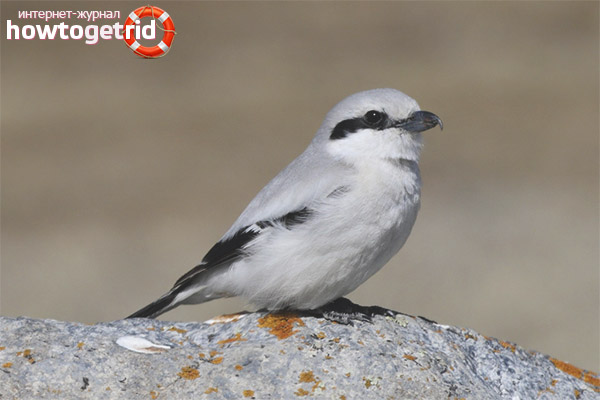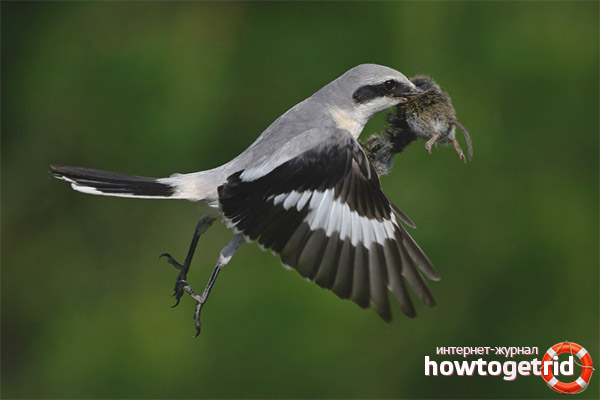The content of the article
The gray shrike bird is considered a real hermit, since it is extremely rare to see it in nature. If you still really want to see representatives of this species, you will have to stock up a lot of patience and be careful. These birds are trying to stay away from humans as far as possible. They usually live at the edge of the forest or near swamps. Birds sit high on a tree or on bushes. The singing of this bird resembles the sounds made by the magpie.
To date, the number of gray shrikes is small. Therefore, they are protected by law. The decrease in numbers is due to the fact that swamps and forests that were their home are being destroyed. To preserve shrikes, like many other bird species, you need to be careful about nature.
Appearance
This bird has rather large sizes in comparison with its relatives. The body length is approximately 27 cm. The bird weighs up to 70 g. The plumage of them is light. On the back, it has an ashy shade. Their abdomen is white. A picture is visible on the breast. The wings are black. Their tail is long, also painted black. There are light stripes on the tail and wings. On the head there are also stripes in the form of a black mask, which begins near the beak, and passes through the eyes of the bird. Shrike is a bird of prey. Therefore, her beak has a characteristic hooking. It is difficult to distinguish a female shrike from a male. Their color is the same, but the males are slightly larger. These birds fly in waves.
Living in nature
The bird lives in the mountains and in the taiga. Those individuals that live in northern latitudes fly away to warmer areas for the winter.
Vote
The sounds made by the gray shrike are very reminiscent of the sound of a magpie. They have a rather rude voice, so their song cannot be called melodic. It is something like whistling, buzzing and creaking. Sometimes the shrike repeats the sound that he heard from another bird. Therefore, the older the male, the better he sings.
Sounds made by representatives of this species are a way of communicating with each other. When he feels the danger is approaching, they often repeat the “check-check”. During the mating season, they also sing a special song.
Food
If we compare the shrike with other birds of prey, then its size is not very large. But this is offset by the courage they show during the hunt. They feed on any prey that they can overcome. Often, various large insects serve as food for them. They eat locusts, beetles, dragonflies. Since it is difficult to find insects in the northern latitudes, birds catch small vertebrates. They like to catch lizards and small amphibians. Sometimes small birds, such as a tit or a sparrow, and even rodents, become their victims. The shrike can feed on mice, voles, and even moles.
As soon as they catch the victim, they immediately eat it. They make stocks extremely rarely. If the bird feels that a lot of food can be caught at the moment, it can sometimes dry its prey. But not all individuals do this.
Nesting
Since gray shrikes are quite large birds, their nest also has appropriate sizes. As a rule, only the female is engaged in the arrangement. Males can only occasionally help them. First, the bird chooses the most suitable branch on which to place its nest. Most often this happens to be a thick branch of a tree or a shoot of a bush. In addition, the nest can be located directly at the trunk. The shrivel usually picks a branch at low altitude. Nests rise above the ground by only 1 m or a little more. It consists of two layers. From the outside it is woven from twigs and blades of grass. A distinctive feature of the nests of these birds is that they use during their construction branches on which green leaves remained.
Inside the nest is lined with soft material. The bird finds animal hair, thin grass and many feathers.
Young individuals

The nesting period may occur at different times. It depends on where the birds live. In the southern parts of the range, they can begin a breeding season in the middle or end of spring. Those shrikes who live north begin to build nests only in June. Their eggs are greenish, covered with small brown spots. In total there are about 5-6 pieces in the masonry. The female shrike is engaged in hatching most of the time. The male can replace her only occasionally.
Interesting Facts
This bird is particularly cunning. They love to tease larger predators. When they see a hawk or a falcon nearby, they climb onto a high branch and begin to sing, as if they did not notice anyone around. When a large predator notices a potential prey, he quickly rushes in her direction. But the cunning bird immediately hides in the thicket.
They can drive away any, even the largest birds. This is also achieved by cunning. The shrike specifically spoils the hunt not only for birds of prey, but also for mammals, warning a possible victim about the approach of the enemy with the help of sounds. In this way, the shrike achieves complete calm. Nobody lives on its territory.
Video: Gray Shrike (Lanius excubitor)











Submit